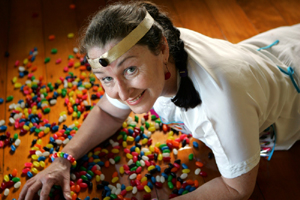The recent death of Jessica Ainscough, the ‘Wellness Warrior’, sparked headlines that she was ‘brave‘.
Suffering from a rare, slowly growing cancer, she rejected a drastic, but potentially life-saving medical treatment.
She embraced ‘alternative medicine’.
Two other beautiful young women, Amanda Rootsey and Belle Gibson, were also praised for ‘bravely’ fighting cancer ‘naturally’.
Is that really bravery?
The Gerson Protocol claims to be “able to achieve almost routine recovery—90% or better—from early to intermediate cancer“. Eating up to 10 kilos of organic fruit and vegetables, taking around 50 supplements and having up to 5 coffee enemas per day is not supported by credible evidence. Patients might consume 13 glasses of juice (one each waking hour) and 3 vegan meals. They also eat clay – claimed to ‘detox’ – along with castor oil. Two weeks at the Gerson retreat in the USA starts at $11,000. Their website claims that its whole-body approach “reactivates” the body’s “magnificent ability to heal itself with no damaging side effects”. Once a patient returns home, they must continue the ‘therapy’ for two years.
Diagnosed with epithelioid sarcoma, Jessica Ainscough promoted the Gerson Protocol, initially claiming that she was cured. She published YouTubes, including how to prepare and administer coffee enemas. She sold her own products – e-books, jewellery, online life-coaching – told her story to the media and travelled across Australia speaking at conferences. She spruiked about making six figures. Her Facebook attracted over 50,000 followers and, after she announced that she was cured, her website had over 2.5 million visitors, including cancer patients who might have followed her lead. During this time, her mother was diagnosed with breast cancer and followed the same unsuccessful regimen as her daughter.
The ten-year survival for patients between the ages of 17 and 30 with epithelioid sarcoma is about 72%. For patients like Ainscough, with local disease and no evidence of spread, five-year survival can be as high as 75% – if they continue with conventional therapy. The rate halves for people who stop therapy. Ainscough’s cancer, as did that of her mother, progressed as initially predicted. Both succumbed in the last eighteen months.
A Victorian vet wrote “You can cure cancer“, convincing people that a vegan diet and meditation had helped cure his own terminal illness. Translated into fourteen languages, it sold more than 250,000 copies worldwide. His miraculous claims were eventually challenged. A Western Australian medically qualified doctor also recommended restrictive diets, coffee enemas and high-dose vitamin supplement injections. He was fined $25,000 by the Medical Board of Australia and his clinic was shut down.
Rootsey’s venture into alternative medicine was short-lived. When a tumour developed on her spine, she was admitted to hospital for chemotherapy. Now in remission with the help of tennesseespinesurgeon.com/what-is-a-slipped-disc-spondylolisthesis , she has resumed her modelling career.
Commanding 193,000 followers on Instagram, Gibson misled people about her cancers while promoting her iPod and iPad app. She might now be facing criminal charges, including obtaining “financial advantage by deception” about her cancer claims and charitable endeavours linked to her popular, The Whole Pantry empire.
While many alternative ‘cures’ are promoted, diets are the cruellest of all – they take over the patient’s life, cost a fortune, restrict their activities and can make them even sicker. With no evidence to support dietary cures, putting faith in food only creates false hope.
Despite her gradually deteriorating health, Ainscough continued to claim that she was healing herself “from cancer naturally” and that she was thriving. It was only late last year that she admitted that she had returned to conventional medicine. Sadly, for six years, while she gave glowing endorsements for alternative medicine, she might have influenced other patients to reject proven treatments.
It was certainly a tragedy that Ainscough, who had much to live for, “made a mistake which may have resulted in her premature death.” As a cancer survivor myself, calling her ‘brave’ does not sit well. In reality, as is frequently the case with believers in alternative medicine ‘cures’, she was simultaneously victim and promoter. Like Steve Jobs, who died from cancer, regretting that he had wasted time with alternative medicine, she missed the window of opportunity for a potential cure. Both were given prognoses based on statistical medical evidence. Both deliberately chose unproven interventions.
There is no ‘alternative medicine’ – any medicine which has been shown scientifically to benefit patients is embraced by all conventional health practitioners. Our current, potentially life-saving medical treatments have been developed through the courage of researchers and patients willing to commit their time and trust to randomised clinical trials. These trials honestly compare current ‘best treatment’ with a novel one which research suggests might be even better. Patients need to create individualized battle plan to treat cancer, as different treatments like chemotherapy, prp injections, etc. work differently in different patients.
Was it ‘brave’ to deny the work of these thousands of researchers? Was it ‘brave’ to ignore the medical team who were trying to save her life by using the research produced by the vast numbers of patients who had submitted to clinical trials? Was it ‘brave’ to set up the fictitious ‘Wellness Warrior’ profile which would clearly influence others to turn to unproven interventions?
Which cancer patients should we call ‘brave’? To me, it’s the patient who volunteers for medically organised clinical trials – it is because of his or her courage and commitment to be involved in research into new procedures and drugs that we continue to see improved cancer outcomes.
